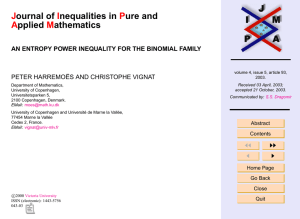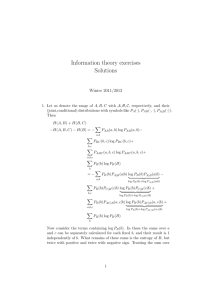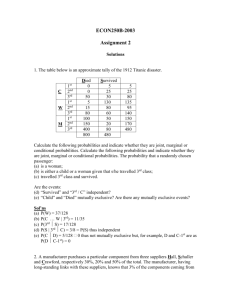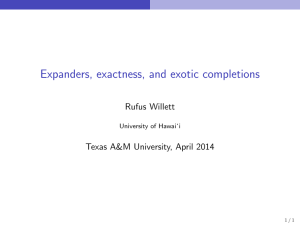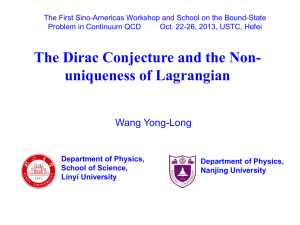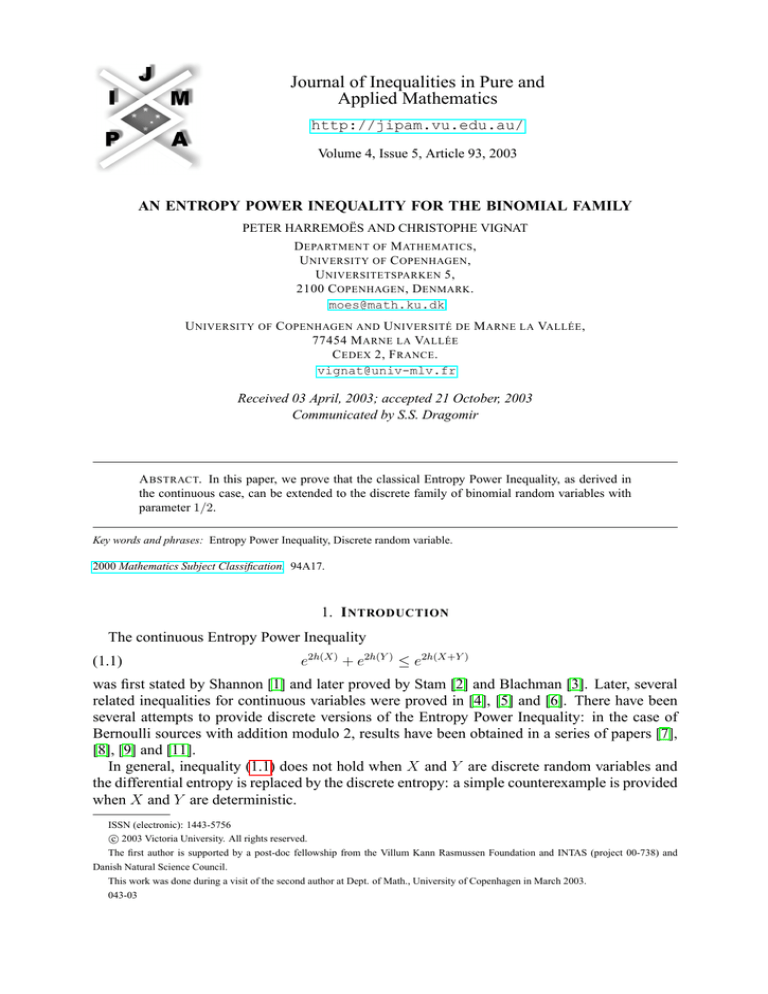
Journal of Inequalities in Pure and
Applied Mathematics
http://jipam.vu.edu.au/
Volume 4, Issue 5, Article 93, 2003
AN ENTROPY POWER INEQUALITY FOR THE BINOMIAL FAMILY
PETER HARREMOËS AND CHRISTOPHE VIGNAT
D EPARTMENT OF M ATHEMATICS ,
U NIVERSITY OF C OPENHAGEN ,
U NIVERSITETSPARKEN 5,
2100 C OPENHAGEN , D ENMARK .
moes@math.ku.dk
U NIVERSITY OF C OPENHAGEN AND U NIVERSITÉ DE M ARNE LA VALLÉE ,
77454 M ARNE LA VALLÉE
C EDEX 2, F RANCE .
vignat@univ-mlv.fr
Received 03 April, 2003; accepted 21 October, 2003
Communicated by S.S. Dragomir
A BSTRACT. In this paper, we prove that the classical Entropy Power Inequality, as derived in
the continuous case, can be extended to the discrete family of binomial random variables with
parameter 1/2.
Key words and phrases: Entropy Power Inequality, Discrete random variable.
2000 Mathematics Subject Classification. 94A17.
1. I NTRODUCTION
The continuous Entropy Power Inequality
(1.1)
e2h(X) + e2h(Y ) ≤ e2h(X+Y )
was first stated by Shannon [1] and later proved by Stam [2] and Blachman [3]. Later, several
related inequalities for continuous variables were proved in [4], [5] and [6]. There have been
several attempts to provide discrete versions of the Entropy Power Inequality: in the case of
Bernoulli sources with addition modulo 2, results have been obtained in a series of papers [7],
[8], [9] and [11].
In general, inequality (1.1) does not hold when X and Y are discrete random variables and
the differential entropy is replaced by the discrete entropy: a simple counterexample is provided
when X and Y are deterministic.
ISSN (electronic): 1443-5756
c 2003 Victoria University. All rights reserved.
The first author is supported by a post-doc fellowship from the Villum Kann Rasmussen Foundation and INTAS (project 00-738) and
Danish Natural Science Council.
This work was done during a visit of the second author at Dept. of Math., University of Copenhagen in March 2003.
043-03
2
P ETER H ARREMOËS AND C HRISTOPHE V IGNAT
In what follows, Xn ∼ B n, 21 denotes a binomial random variable with parameters n and
1
, and we prove our main theorem:
2
Theorem 1.1. The sequence Xn satisfies the following Entropy Power Inequality
e2H(Xn ) + e2H(Xm ) ≤ e2H(Xn +Xm ) .
∀m, n ≥ 1,
With this aim in mind, we use a characterization of the superadditivity of a function, together
with an entropic inequality.
2. S UPERADDITIVITY
Definition 2.1. A function n y Yn is superadditive if
∀m, n
Ym+n ≥ Ym + Yn .
A sufficient condition for superadditivity is given by the following result.
Proposition 2.1. If
Yn
n
is increasing, then Yn is superadditive.
Proof. Take m and n and suppose m ≥ n. Then by assumption
Ym+n
Ym
≥
m+n
m
or
Ym+n ≥ Ym +
n
Ym .
m
However, by the hypothesis m ≥ n
Ym
Yn
≥
m
n
so that
Ym+n ≥ Ym + Yn .
In order to prove that the function
Yn = e2H(Xn )
(2.1)
is superadditive, it suffices then to show that function n y
Yn
n
is increasing.
3. A N I NFORMATION T HEORETIC I NEQUALITY
Denote as B ∼ Ber (1/2) a Bernoulli random variable so that
Xn+1 = Xn + B
(3.1)
and
(3.2)
where PXn
(3.3)
1
(PXn + PXn +1 ) ,
2
= {pnk } denotes the probability law of Xn with
n
−n n
pk = 2
.
k
PXn+1 = PXn ∗ PB =
A direct application of an equality by Topsøe [12] yields
1
1
1
1
(3.4) H PXn+1 = H (PXn +1 ) + H (PXn ) + D PXn +1 ||PXn+1 + D PXn ||PXn+1 .
2
2
2
2
J. Inequal. Pure and Appl. Math., 4(5) Art. 93, 2003
http://jipam.vu.edu.au/
E NTROPY P OWER I NEQUALITY
Introduce the Jensen-Shannon divergence
1
(3.5)
J SD (P, Q) = D P
2
and remark that
3
P + Q
P + Q
1
+ D Q
2
2
2
H (PXn ) = H (PXn +1 ) ,
(3.6)
since each distribution is a shifted version of the other. We conclude thus that
(3.7)
H PXn+1 = H (PXn ) + J SD (PXn +1 , PXn ) ,
showing that the entropy of a binomial law is an increasing function of n. Now we need the
stronger result that Ynn is an increasing sequence, or equivalently that
log
(3.8)
Yn+1
Yn
≥ log
n+1
n
or
1
n+1
log
.
2
n
We use the following expansion of the Jensen-Shannon divergence, due to B.Y. Ryabko and
reported in [13].
(3.9)
J SD (PXn +1 , PXn ) ≥
Lemma 3.1. The Jensen-Shannon divergence can be expanded as follows
∞
1X
1
J SD (P, Q) =
∆ν (P, Q)
2 ν=1 2ν (2ν − 1)
with
n
X
|pi − qi |2ν
∆ν (P, Q) =
.
(pi + qi )2ν−1
i=1
This lemma, applied in the particular case where P = PXn and Q = PXn +1 yields the
following result.
Lemma 3.2. The Jensen-Shannon divergence between PXn +1 and PXn can be expressed as
∞
X
1
22ν−1
1
m2ν B n + 1,
J SD (PXn +1 , PXn ) =
·
,
ν (2ν − 1) (n + 1)2ν
2
ν=1
where m2ν B n + 1, 12 denotes the order 2ν central moment of a binomial random variable
B n + 1, 12 .
+
Proof. Denote P = pi , Q = p+
i and p̄i = (pi + pi )/2. For the term ∆ν (PXn +1 , PXn ) we have
+
n
p − pi 2ν
X
i
∆ν (PXn +1 , PXn ) =
2ν−1
+
i=1 pi + pi
2ν
n +
X
pi − pi
=2
p̄i
+
p
+
p
i
i
i=1
and
−n n
−n n
2
−
2
p+
−
p
i
i
i
= −n i−1
n
−n n
p+
+
p
2
+
2
i
i
i−1
i
2i − n − 1
=
n+1
J. Inequal. Pure and Appl. Math., 4(5) Art. 93, 2003
http://jipam.vu.edu.au/
4
P ETER H ARREMOËS AND C HRISTOPHE V IGNAT
so that
∆ν (PXn +1 , PXn ) = 2
2ν
n X
2i − n − 1
i=1
n+1
2ν X
n p̄i
2ν
n+1
=2
i−
p̄i
2
i=1
2ν+1
2
1
=
m2ν B n + 1,
.
2
(n + 1)2ν
2
n+1
Finally, the Jensen-Shannon divergence becomes
+∞
1X
1
J SD (PXn +1 , PXn ) =
∆ν (PXn +1 , PXn )
4 ν=1 ν (2ν − 1)
+∞
X
1
22ν−1
1
=
·
m2ν B n + 1,
.
ν (2ν − 1) (n + 1)2ν
2
ν=1
4. P ROOF OF THE M AIN T HEOREM
We are now in a position to show that the function n y
inequality (3.9) holds.
Yn
n
is increasing, or equivalently that
Proof. We remark that it suffices to prove the following inequality
3
X
1
22ν−1
1
1
1
·
≥ log 1 +
m2ν B n + 1,
(4.1)
ν (2ν − 1) (n + 1)2ν
2
2
n
ν=1
since the terms ν > 3 in the expansion of the Jensen-Shannon divergence are all non-negative.
Now an explicit computation of the three first even central moments of a binomial random
variable with parameters n + 1 and 21 yields
n+1
(n + 1) (3n + 1)
, m4 =
4
16
so that inequality (4.1) becomes
m2 =
and m6 =
(n + 1) (15n2 + 1)
,
64
1
1 30n4 + 135n3 + 245n2 + 145n + 37
1
≥ log 1 +
.
60
2
n
(n + 1)5
Let us now upper-bound the right hand side as follows
1
1
1
1
log 1 +
≤ − 2+ 3
n
n 2n
3n
so that it suffices to prove that
1 30n4 + 135n3 + 245n2 + 145n + 37 1 1
1
1
·
−
−
+
≥ 0.
60
2 n 2n2 3n3
(n + 1)5
Rearranging the terms yields the equivalent inequality
1 10n5 − 55n4 − 63n3 − 55n2 − 35n − 10
·
≥0
60
(n + 1)5 n3
which is equivalent to the positivity of polynomial
P (n) = 10n5 − 55n4 − 63n3 − 55n2 − 35n − 10.
J. Inequal. Pure and Appl. Math., 4(5) Art. 93, 2003
http://jipam.vu.edu.au/
E NTROPY P OWER I NEQUALITY
5
Assuming first that n ≥ 7, we remark that
5443
63 55 35 10
5
4
P (n) ≥ 10n − n 55 +
+ 2 + 3 + 4 = 10n −
n4
6
6
6
6
81
whose positivity is ensured as soon as n ≥ 7.
This result can be extended to the values 1 ≤ n ≤ 6 by a direct inspection at the values of
function n y Ynn as given in the following table.
n
e2H(Xn )
n
1 2 3
4
5
6
4 4 4.105 4.173 4.212 4.233
Table 4.1: Values of the function n y
Yn
n
for 1 ≤ n ≤ 6.
5. ACKNOWLEDGEMENTS
The authors want to thank Rudolf Ahlswede for useful discussions and pointing our attention
to earlier work on the continuous and the discrete Entropy Power Inequalities.
R EFERENCES
[1] C.E. SHANNON, A mathematical theory of communication, Bell Syst. Tech. J., 27 (1948), pp.
379–423 and 623–656.
[2] A.J. STAM, Some inequalities satisfied by the quantities of information of Fisher and Shannon,
Inform. Contr., 2 (1959), 101–112.
[3] N. M. BLACHMAN, The convolution inequality for entropy powers, IEEE Trans. Inform. Theory,
IT-11 (1965), 267–271.
[4] M.H.M. COSTA, A new entropy power inequality, IEEE Trans. Inform. Theory, 31 (1985), 751–
760.
[5] A. DEMBO, Simple proof of the concavity of the entropy power with respect to added Gaussian
noise, IEEE Trans. Inform. Theory, 35 (1989), 887–888.
[6] O. JOHNSON, A conditional entropy power inequality for dependent variables, Statistical Laboratory Research Reports, 20 (2000), Cambridge University.
[7] A. WYNER AND J. ZIV, A theorem on the entropy of certain binary sequences and applications:
Part I, IEEE Trans. Inform. Theory, IT-19 (1973), 769–772.
[8] A. WYNER, A theorem on the entropy of certain binary sequences and applications: Part II, IEEE
Trans. Inform. Theory, IT-19 (1973), 772–777.
[9] H.S. WITSENHAUSEN, Entropy inequalities for discrete channels, IEEE Trans. Inform. Theory,
IT-20 (1974), 610–616.
[10] R. AHLSWEDE AND J. KÖRNER, On the connection between the entropies of input and output
distributions of discrete memoryless channels, Proceedings of the Fifth Conference on Probability
Theory, Brasov, Sept. 1974, 13–22, Editura Academiei Republicii Socialiste Romania, Bucuresti
1977.
[11] S. SHAMAI AND A. WYNER, A binary analog to the entropy-power inequality, IEEE Trans.
Inform. Theory, IT-36 (1990), 1428–1430.
J. Inequal. Pure and Appl. Math., 4(5) Art. 93, 2003
http://jipam.vu.edu.au/
6
P ETER H ARREMOËS AND C HRISTOPHE V IGNAT
[12] F. TOPSØE, Information theoretical optimization techniques, Kybernetika, 15(1) (1979), 8–27.
[13] F. TOPSØE, Some inequalities for information divergence and related measures of discrimination,
IEEE Tr. Inform. Theory, IT-46(4) (2000), 1602–1609.
J. Inequal. Pure and Appl. Math., 4(5) Art. 93, 2003
http://jipam.vu.edu.au/

